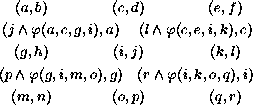Another construction in the cartesian product of state spaces yields
automata whose evolution can be reversed; it is based on ideas
originating with Edward Fredkin. This time we need just one rule,
![]() , with which the following composite rule of evolution
can be created:
, with which the following composite rule of evolution
can be created:
![]()
This definition has a leftward orientation, with an entirely similar definition leaning to the right. Likewise, the exclusive or could be replaced by any other invertible function; for binary automata the only alternative would be the exclusive nor.
To undo the evolution, consider the evolution of three successive cells:
![]()
we would like to recover the state ![]() from the second
line. Although a is readily available, it is necessary to liberate
b from the combination
from the second
line. Although a is readily available, it is necessary to liberate
b from the combination ![]() . Given that both a and
c are available,
. Given that both a and
c are available, ![]() can be calculated, then used to
release b from the invertible combination in which it is bound.
can be calculated, then used to
release b from the invertible combination in which it is bound.
Altogether this is a process embodied in the rule
![]()
which must be the rule which will reverse the evolution resulting from the application of the first.
To apply these ideas in two dimensions, consider the following layout:

wherein the rule of evolution is evidently
![]()
As before, there is enough information in the second generation cells
surrounding the first generation cell ![]() to recover
to recover ![]() ; the
appropriate rule is:
; the
appropriate rule is:
![]()
Again following the one dimensional case, these definitions can be
oriented toward different directions, just as the connective ![]() can be assigned different meanings. Such variants do not necessarily
yield all possible invertible rules; historically very few were known
until Fredkin proposed ``second order'' rules, of which these are a
variant.
can be assigned different meanings. Such variants do not necessarily
yield all possible invertible rules; historically very few were known
until Fredkin proposed ``second order'' rules, of which these are a
variant.
Every binary rule leads to a distinct pair of reversible quaternary rules (some of which may be self-reversible, and some pairs of which may have been generated by a pair of binary rules), even when the binary rule itself is not reversible; there are also cases in which the binary rule was already reversible.